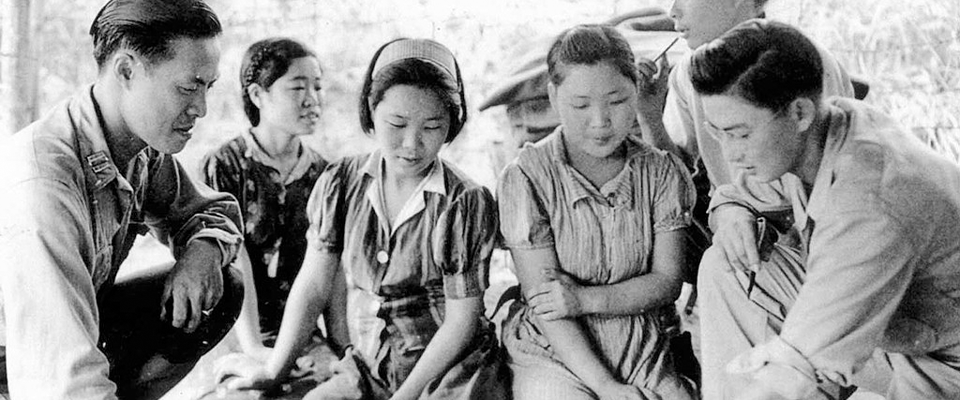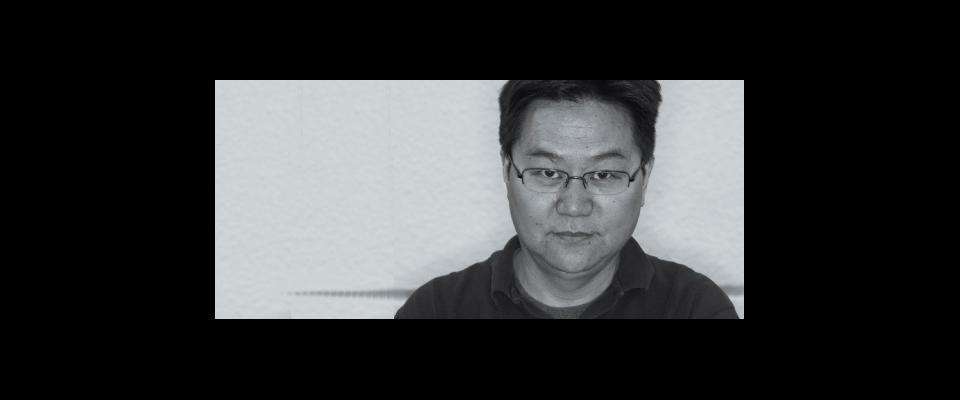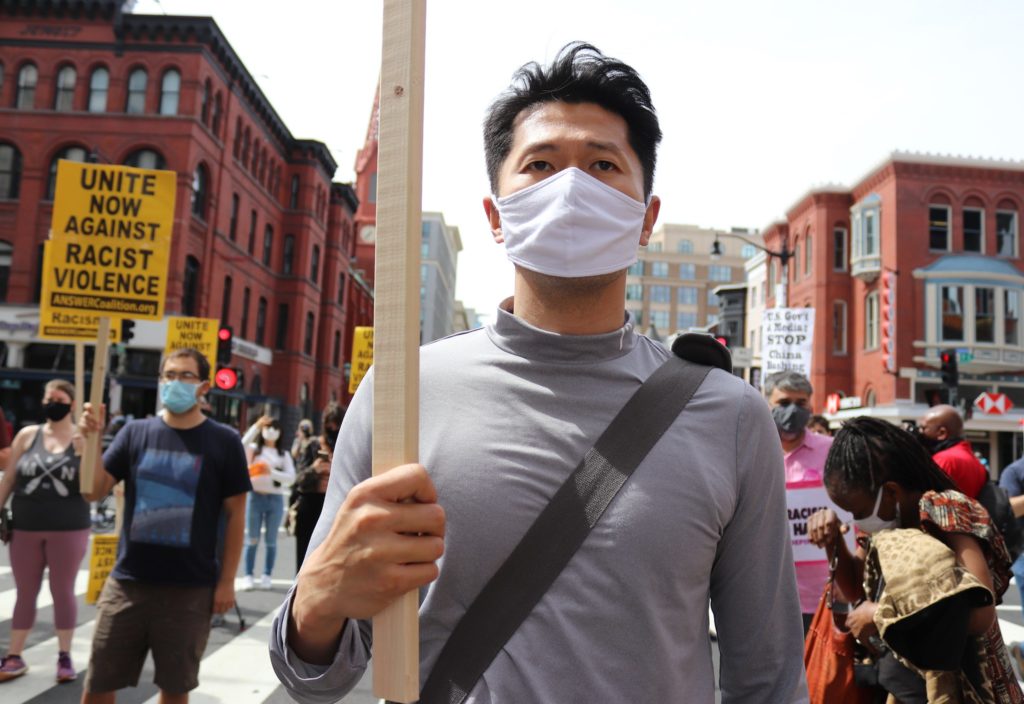“Why and how is it,” writes Laura Hyun Yi Kang in her 2020 book Traffic in Asian Women, “so many Asian women continue to suffer in the same coeval space of so much publicity, knowledge production, and activism?”
In her research, Kang, a Berkeley grad and professor in the department of gender and sexuality studies at UC Irvine, explores how the societal role and perception of Asian women have long been a reflection of underlying structures of power.

Beginning with WWII, she looks at the brutal history of the Japanese military system of sexual slavery in which, for more than ten years, the Imperial Japanese Army forced thousands of women, primarily Korean and Chinese, into brothels, or “comfort stations.” Kang argues that, then and in recent history, Asian women have either been ignored or thought of as helpless victims of political and sexual exploitation. This flattening of the Asian female identity, she says, prevents survivors of violence, forced migration, and other forms of oppression from accessing justice.
In seeking a path forward, particularly in the wake of a surge in anti-Asian violence including the recent shooting in Atlanta, GA, Kang urges society to challenge the monolithic labels of identity and “broaden our concern and analytical compass to all the people who suffer from state violence, labor exploitation, forced migration, deportation.”
This conversation has been edited for length and clarity.
In your book you talk about how Asian women can be thought of as a method to understand power more broadly. What does that mean?
It’s very important to keep in mind that even though that category of “Asian women” is often used to refer to a specific group of people, including [the women killed] in Atlanta, it overgeneralizes a huge and diverse population. In some ways, even though the term seems to pay attention to the specificity of race, ethnicity, and gender, at the same time it elides important differences.
What I really wanted to challenge and provoke with this book was: Can you think about Asian women as a kind of portal for thinking, rather than thinking about them as a delimited population? Precisely because of their unknowability, the category of Asian women is an interesting concept to think with and offers a kind of challenge for how we investigate.
What inspired your research into the decades of global and U.S. inattention to Asian women?
The book itself was inspired by a kind of a puzzle that looks into why Asian women come into incredible international visibility in the 1990s, specifically around the case of the Japanese military “comfort system,” more accurately refered to as “Japanese military sexual slavery,” which is the preferred term of the survivors and activists.

Considering these extremely public instances of violence against Asian women, violent exploitation of Asian labor, and physical displacement of Asian women, I wondered: How were these things allowed to happen in the first place? At the time there were, supposedly, international conventions in place to prevent such things. The other element I was curious about was this long gap of silence between the actual historical occurrence in the 1930s and 40s and the international attention and, frankly, shock in the 1990s. I contextualize this as a kind of inability or unwillingness to even fundamentally recognize the Japanese military sexual slavery system as a problem. And finally—after an international campaign to listen to survivors in the 1990s, a global movement to recognize women’s rights as human rights, and a kind of shock that this happened in the first place—there was hope that survivors might see some justice. And I realized that justice didn’t happen, and I wanted to know why.
I thought: Maybe there’s actually something about the very mechanisms of justice itself that are the problem. In other words, the problem was in the how not just in the what of history. That’s what I mean by using Asian women as method: Instead of thinking about Asian women as these objects to observe or victims to pity, that mode of sympathy actually doesn’t get us anywhere and more importantly, that thinking doesn’t get us justice. That thinking relegates Asian women to a category of spectacularly victimized bodies. If we really want to pay serious attention to Asian women, we have to understand that we can’t do so without studying how global governance is established, who documented atrocities committed against Asian women, and who wrote the declarations decrying those violences.
At the same time we can’t ask about justice without bringing in a really important issue that gets lost when we talk about Asian women or think about them largely as sexualized figures, especially victims of sexual violence: socioeconomic inequality and labor exploitation. To examine Asian women requires that we evaluate the story of how capitalism itself developed and mutated—and the 20th century, as well.
Can you talk about the history of governmental attempts to “protect” women and the results of those efforts?
The category of “traffic in women” became installed in global governance specifically through the League of Nations in the 1920s. [The League of Nations] witnessed [World War I] and believed that some mechanism had to be established for the sake of international peace, but at the same time many of these actors did not want to give up their own particular sovereignty and colonial power. The one thing they could actually all agree on was that they all wanted to protect women. The first study they commissioned was [the 1921 International Convention for the Suppression of the Traffic in Women and Children] that was largely relegated to looking at Europe, parts of the U.S., and South America. Only after they published this study did they realize that there was this whole swath of the world that they didn’t cover. So they decided to do a second study looking at traffic in women in the East.
The report, right from the start, makes a differentiation between two different forms of traffic in women [Asian women and white women] that they find in the “East.” Investigators separated out and demoted Asian women from this category of white women; even when Asian women are supposedly centered in study, they still become subordinated. They still remain unintelligible or invisible because of racialist blind spots and because of the inheritance of a much longer history about the sexual fate of white women in the aftermath of multiple empires and migrations.
You’ve said that the way these histories were documented prevented the victims from seeing real justice. How is that?
Both the U.S. military and the federal government were implicated in, and in some ways complicit with the forgetting of the Japanese Military comfort system. I actually did a close examination of the U.S. military archives, finding that the U.S. recorded sightings of the comfort system during WWII.
The 50 years of so-called silence were in fact not about silence, and I challenge why this insight doesn’t get picked up much more seriously and substantively within U.S. feminist studies. If we actually look at the scholarship and activism that women in Asia were engaging with as early as the 1970s in Korea and in Japan, the history of the comfort system was actually never forgotten. Many of the people who survived the colonial period knew women who had been conscripted or knew that there was this history. Why was it not taken up as a serious matter for sustained feminist inquiry? Excuses of access or language barriers don’t hold up. In the 1970s and 80s, U.S. feminist scholars were writing on female injury, gendered violence, and sexual slavery. A canonical feminist book [Female Sexual Slavery by Kathleen Barry] on the subject actually features an article by a Japanese journalist, Yayori Matsui, who wrote extensively about Japanese military sexual enslavement. For some reason, the author doesn’t pay attention to Matsui’s invocation of the comfort system. To me, this is a clear example that even when presented with a really important historical atrocity, major feminist scholars didn’t register it. I think it’s because there’s a way in which scholarship encourages study of Asian women as mere examples of atrocities or appendage to the study of those atrocities, rather than a substantive basis or jumping off point of study.
This year, incidents of anti-Asian violence have entered daily conversation. After the spa shootings in Atlanta, many outlets reported that over 3,000 recorded instances of anti-Asian hate crimes and attacks in the past year, insinuating that the shooting was the culmination of similar hate crimes. How did you interpret what happened in Atlanta?
I was personally troubled by the immediate impulse to link this to that chain of anti-Asian violence, partly because I felt like in the immediate aftermath of the incident we hadn’t even been able to identify the Korean women. I thought it was premature, not to mention that two other people who were murdered were not Asian. I’m not trying to take attention away from this atrocious wave of anti-Asian hate, but I worry about trying to sweep complicated specific cases into a trend.
When we sweep those six Asian women under that rubric of anti-Asian violence, we lose sight of the fact that they weren’t killed just for being Asian; they weren’t placed in this position of vulnerability just because of race. Rather than quickly move to uphold them as emblematic cases of victims of anti-Asian violence, we should be even more critical about why we needed this atrocious incident for all these mainstream media outlets to suddenly care about anti-Asian violence. There should be a more sustained interrogation of that wave of anti-Asian violence that has been happening.
After the shooting, journalists interviewed scholars to try and understand what happened. I found that many of them were talking about their own experiences with anti-Asian racism and misogyny. This troubled me—linking forms of racism and misogyny—because even though I have also had racist and misogynistic experiences, those instances make me a really different Asian woman than these six victims. I was really upset about what happened, but not because they were Asian women; I was really upset because they were other human beings who led difficult, hardworking lives that placed them in this position of vulnerability that I don’t have to be in. I thought it would have been obscene for me to speak as if they and I shared any kind of identity.
My experiences of racism and misogyny don’t show that I’m an Asian woman like them; it actually shows that we are totally different kinds of Asian women. I think some of the media coverage, in relying on disparate testimony and conflating one Asian woman’s experience with another’s, ended up reproducing Asian women and Asian American women as these newly vulnerable figures.
And ignoring how Asian women have historically been made vulnerable, and then disregarded, by systems of power?
Ignoring history, and for me, ignoring really different inequalities of power, safety and privilege among Asian and Asian American women.
What does justice look like to you?
This is something that I actually end the book with. I returned to the figure of the women who were forcibly inducted into the Japanese military comfort systems and then I asked: How do we remember them? How do we remember this history? If we really care about them and if we really want to be attentive to the fact that they were subject to multiple forms of oppression, exploitation, and degradation—such as forcible movement, unfair detention, uncompensated labor—what does justice look like?
When we move to justice I want us to move away from the identity category. I want others to think about forms of injustice, and the many other people who are subject to those forms of injustice, and then want to change the conditions for everyone affected by them.





















